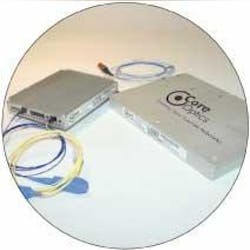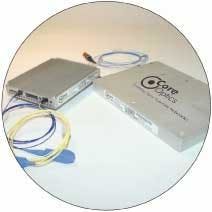Marconi, CoreOptics partner on MLSE-based engine
Marconi and CoreOptics’ jointly developed electronic distortion equalization (EDE) engine is based on Maximum Likelihood Sequence Estimator (MLSE) technology. The MLSE algorithm has been used successfully in low-throughput applications, including disk drives and mobile wireless communications. Adapting the technology for use in high-speed optical transmission systems proved to be quite challenging, however. At the time of the project’s inception, “no one was able to deliver such a product nor were they willing to take the risk to do such a development,” recalls Joerg-Peter Elbers, director of technical evolution at Marconi.
The chipset was a challenge to develop because it comprises two parts, both of which require significant expertise, contends CoreOptics sales and marketing vice president Saeid Aramideh. “The main part is the MLSE engine itself, the digital equalization engine. But to make this digital engine work in the optical system, you need a very-high-performance clock and data recovery [CDR] scheme that can recover the clock in the presence of noise,” he says.
Adding to the complexity of an MLSE-based equalizer is the use of a built-in blind-channel estimator. “Instead of using a decision circuit, which makes independent bit-by-bit decisions based on a fixed threshold level, the MLSE operates on bit sequences,” explains Elbers. “It selects the most probable sent bit sequence conditional to the received and analog/digital converted sequence. By this approach, the receiver can tolerate more intersymbol interference, irrespective of where distortions originate from.”
According to both CoreOptics and Marconi, the companies have achieved their original goal: Develop an MLSE-based EDE engine that acts adaptively as part of the receiver to compensate for optical and electrical distortions that accumulate across a metro-network link. Using the adaptive distortion-tolerant transponder, network operators can eliminate the expense of dispersion-compensating fiber (DCF) and replace dual-stage amplifiers with less expensive amplifiers.
Such a device will also enable network convergence at the optical layer, a hot topic in the carrier community. “Today, you need different transponders for metro, metro core, and long-haul applications,” says Aramideh. “Because optics are expensive, people typically have high-premium optics for long-haul transponders and line cards and lower-premium optics for the metro. Using a solution like MLSE, you can actually relax the specification on optics; you don’t need to have high-performance optics because the detection of the signal is done at the receiver end, and it’s done through electronics. You can have a universal transponder.”
For now, CoreOptics integrates the MLSE-based electronic engine into a 300-pin MSA transponder. Because it is modular in design, the chipset can be easily integrated into different building blocks in the future, including the small-form-factor architectures favored by the system vendors. “It is interesting for us and for our competitors to get this in smaller footprints, like an XFP package,” admits Marconi’s Elbers.
According to Aramideh, Marconi’s competitors are very much interested. “There are other tier one system vendors that are actually in the final stage of system integration” with the adaptive distortion-tolerant transponder, he reports. A spate of papers recently at ECOC and earlier this year at OFC indicate that others are embracing MLSE technology; representatives from Lucent Technologies, Nortel Networks, and Alcatel have all delivered presentations on the topic.
